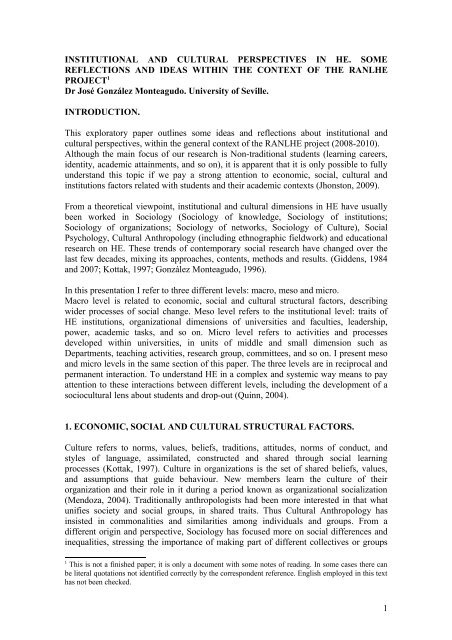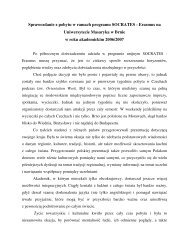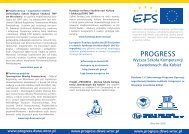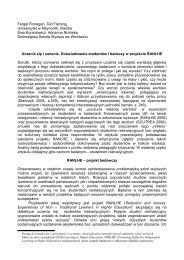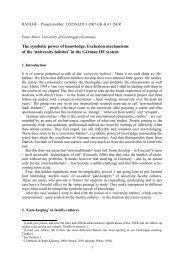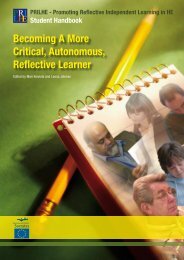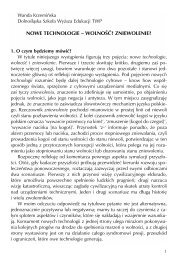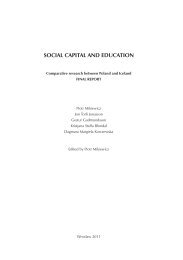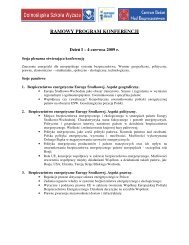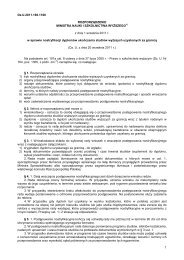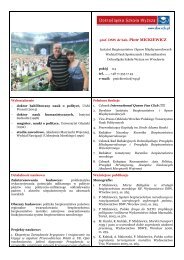INSTITUTIONAL AND CULTURAL PERSPECTIVES
INSTITUTIONAL AND CULTURAL PERSPECTIVES
INSTITUTIONAL AND CULTURAL PERSPECTIVES
You also want an ePaper? Increase the reach of your titles
YUMPU automatically turns print PDFs into web optimized ePapers that Google loves.
<strong>INSTITUTIONAL</strong> <strong>AND</strong> <strong>CULTURAL</strong> <strong>PERSPECTIVES</strong> IN HE. SOMEREFLECTIONS <strong>AND</strong> IDEAS WITHIN THE CONTEXT OF THE RANLHEPROJECT 1Dr José González Monteagudo. University of Seville.INTRODUCTION.This exploratory paper outlines some ideas and reflections about institutional andcultural perspectives, within the general context of the RANLHE project (2008-2010).Although the main focus of our research is Non-traditional students (learning careers,identity, academic attainments, and so on), it is apparent that it is only possible to fullyunderstand this topic if we pay a strong attention to economic, social, cultural andinstitutions factors related with students and their academic contexts (Jhonston, 2009).From a theoretical viewpoint, institutional and cultural dimensions in HE have usuallybeen worked in Sociology (Sociology of knowledge, Sociology of institutions;Sociology of organizations; Sociology of networks, Sociology of Culture), SocialPsychology, Cultural Anthropology (including ethnographic fieldwork) and educationalresearch on HE. These trends of contemporary social research have changed over thelast few decades, mixing its approaches, contents, methods and results. (Giddens, 1984and 2007; Kottak, 1997; González Monteagudo, 1996).In this presentation I refer to three different levels: macro, meso and micro.Macro level is related to economic, social and cultural structural factors, describingwider processes of social change. Meso level refers to the institutional level: traits ofHE institutions, organizational dimensions of universities and faculties, leadership,power, academic tasks, and so on. Micro level refers to activities and processesdeveloped within universities, in units of middle and small dimension such asDepartments, teaching activities, research group, committees, and so on. I present mesoand micro levels in the same section of this paper. The three levels are in reciprocal andpermanent interaction. To understand HE in a complex and systemic way means to payattention to these interactions between different levels, including the development of asociocultural lens about students and drop-out (Quinn, 2004).1. ECONOMIC, SOCIAL <strong>AND</strong> <strong>CULTURAL</strong> STRUCTURAL FACTORS.Culture refers to norms, values, beliefs, traditions, attitudes, norms of conduct, andstyles of language, assimilated, constructed and shared through social learningprocesses (Kottak, 1997). Culture in organizations is the set of shared beliefs, values,and assumptions that guide behaviour. New members learn the culture of theirorganization and their role in it during a period known as organizational socialization(Mendoza, 2004). Traditionally anthropologists had been more interested in that whatunifies society and social groups, in shared traits. Thus Cultural Anthropology hasinsisted in commonalities and similarities among individuals and groups. From adifferent origin and perspective, Sociology has focused more on social differences andinequalities, stressing the importance of making part of different collectives or groups1This is not a finished paper; it is only a document with some notes of reading. In some cases there canbe literal quotations not identified correctly by the correspondent reference. English employed in this texthas not been checked.1
(in function of social class, family background, gender, place of residence, ethniccharacteristics, age and generation) to establish differences and explain socialinequalities.Culture consists of two related yet different dimensions (Kottak, 1997):- Material dimension: material processes related to social activities, located in aspecific time and space; it implies the use and manipulation of specific artefactsrelated, in the case of HE institutions, to knowledge, teaching and research.- Symbolic, mental and cognitive dimension: social and individual processes ofunderstanding, interpretation; symbolic dimension of culture is related to values,norms, beliefs, religions, philosophies and ideologies (this is the level of thesuperstructure proposed by K. Marx).Nowadays culture is characterized by an accelerated process of change; like in othersectors, university culture suffers the impacts of important factors which transforminstitutions, groups, individuals, and traditional habits of thinking and behaviour,legitimated over time (Castells, 2003; Giddens, 2007):- Economic globalization and new systems of management.- Transformation of the Nation-state and forms of political and citizenparticipation.- ITC.- Migrations, ethnic diversity and multiculturalism.- Changing gender relations and the progressive crisis of patriarchy.- Scientific and technological advances.All these factors are impacting upon HE institutions as well as being affected by thework developed in universities. It is a dialectical and complex process. Universities arebeing changed as a result of social transformations and also universities are influencingthese processes as key institutions charged of the creation and diffusion of knowledgeand research. It is important to study how different institutions respond in diverse waysto social and cultural shared settings.Prevailing social and cultural forms of socialization have a strong impact upon thesocialization of academics. The functions and tasks of the universities, within aglobalized and changing context, have been redefined in a contradictory way, under theinfluence of diverse and opposed political, economic, administrative, institutional andprofessional discourses.The impact of ICT is transforming and redefining university teaching. Traditionalcommunication between students and lecturers has been altered and it is complementedby new forms and formats. Teaching programmes developed via digital platforms aregrowing. Conventional teaching programmes also have changed as a result of newtechnologies. In this context, attitudes towards lifelong learning are also changingdramatically.Economic structural factors sometimes tend to be marginalized, emphasizing the role ofinstitutional and cultural factors. Nevertheless it is necessary to pay more attention toeconomic factors which influence academic success, completion and dropout. Thefamily income available, the national and regional economic structure, the labourmarket and the possibilities of employment are important traits. The current economic2
crisis seems to have a double and paradoxical influence on university studies. On theone hand, degrees are not considered as a necessary requirement to access toemployment or to progress in the labour market. In the current context of highunemployment, degrees are not a guarantee to access to the labour market and to stay init (Quinn, 2004, 68, for example, refers to the decline of traditional industries, thelimitation of working opportunities and the lack of an apparent transition from theuniversity degree to the local labour market). On the other hand, the increasing ofunemployment and the decreasing of possibilities for accessing to a job by youngpeople are raising the interest towards HE as a path to improve employability and auseful resource while the economic situation makes better.The impact of social class in relation to university students (learning careers, identity,drop-out, specific difficulties, institutional habitus) remains in many occasions hidden.The social class is considered as an important dimension to analyze primary andsecondary teaching. Nevertheless, in HE class tend to be ignored or marginalized as aperspective of analysis. Many academics do not perceive the social class as an importantissue. It is supposed that, after having accessed the university, there is equality amongstudents, regardless their social or family backgrounds. In this case, there only seemhave an interest towards the fact that students with less economic resources haveavailable grants and financial support. This issue seems to be very relevant for ourproject (on class and class debates, see: Crompton, 2008).Different national contexts have general traits which influence upon HE. Some of thesetraits are:- Contemporary and recent history.- Features and backgrounds of the prevailing political system.- Shared values (i.e.: visions on effort and perseverance, an important dimensionof the academic success).- Use of time, including its implications in relation to yearly cycles of holidays,work, school timetables.- Styles, traditions and socially legitimated ways of socialization, education andfamily values about children and young.- Self-perception of society and groups; stories, narratives, myths, which havebeen legitimated in different ways.- Traditions, feasts and celebrations.- Educational policy, laws and norms on education sector.- Social, economic and cultural profile of the local communities in which arelocated university institutions.- Groups and associations active in the social arena: political parties, trade unions,religious groups, media.- Companies and the private economic sector.- Position of the HE institutions in relation to the public/state and private sectors,including the funding of HE institutions and of the tuition fees.3
2. <strong>INSTITUTIONAL</strong>, ORGANIZATIONAL <strong>AND</strong> <strong>CULTURAL</strong> FACTORS INHE.ECONOMY <strong>AND</strong> MARKET.There exists a strong pressure upon HE institutions to produce more, to be profitableand to compete. Accountability, quality and evaluation are some of the words whichshow this new reality across Europe. This pressure, based on new ways of managementand control, is transforming the processes of research and teaching, as well as thedynamics of faculties and departments, and the professional careers of academics,researchers and lecturers (see for example the Research Assessment Exercise). In thiscontext it is interesting to recover the term of greedy institutions, coined by Coser in1974 (cit. in Wright et al, 2004) to refer to organizations that establish high demands ontheir employees (here is it important the time dimension: academics tend to work morethan previously; around 60 hours a week).SOCIALIZATION.Socialization has usually been approached from three perspectives: functionalist,interpretive and critical (this part about the three perspectives basically comes fromGonzález Monteagudo, 1996, and is based on: Lacey, 1993; Zeichner, 1979). Initiallysocialization had been treated from a functionalist viewpoint, following the Durkheim’sand Comte’s French positivism. Important concepts in this approach are status quo,social order, consensus and social integration. Functionalism is realist, positivist,determinist and nomotetic. Socialization is based on a consensual and static conceptionof society. According to Merton (cit. in Mendoza, 2008), during socialization processindividual acquire the values, attitudes, norms knowledge and skills needed to exist in agiven organization. Functionalism does not pay attention to the importance of differentsocial subgroup nor to differences of class, gender, ethnicity, religion and so on.Functionalism posits that the diverse professional subcultures are all homogeneous anduniforms.The interpretive approach of socialization is antipositivist, nominalist, voluntarist andideographic. Symbolic interactionism has largely contributed to this approach,particularly H. S. Becker, with his pioneering study of medicine students. Socializationis understood as a process over the whole life and career. There are stressed thesubjective meanings of the participants. In Lacey’s study (1993), teachers manifestedtwo main orientations or types of commitment: a radical commitment and a professionalengagement (here we can think about the connections between professional life, on onehand, and personal/ideological life, on the other hand). The active role of individuals istheorized through the concept of social strategy: the activity of the social actor referredto the selection of ideas and actions and the undertaking of complex interactions in aspecific situation. There are three kind of social strategies: a) internalized adjustment(acceptance and fulfilment of norms); strategic obedience (external respect but innerdiscrepancy); and strategic redefinition (searching for new solutions, according to owninterests and expectations).The critical approach of socialization stems from the Marxism and the Frankfurt school.The focus is placed in concepts such as totality, consciousness, alienation and critic. Animportant goal of this approach is to explicit activities and processes which usually aretaken for granted. Critical perspective pays special attention to power relations,inequalities as a result of the institutional functioning. Also there is interest towards4
conflicts and strategies of resistance by groups and individuals. Socialization isunderstood as contradictory, dialectical, collective and individual. To understandsocialization processes it is indispensable to analyze and criticize institutional,historical, social and cultural contexts.Using the concept of socialization it is possible to grasp the complexity and interplaysof macro, meso and micro levels indicated before, in relation to academics and lecturers.In the interactive level, lecturers contribute to construct the learning identity of students,and conversely students configure identity of academics. The colleagues are importantbecause with them it is constructed a subculture of teaching.Socialization process occurs both formally and informally. There is an anticipatorysocialization (mediated by expectations, ideas and previous knowledge), whichinfluences the initial entry into the organization and the different stages through thecareer as a member of the organization (Mendoza, 2004).Weick (cit. in Mendoza, 2004) identifies several vocabularies as forms of exchangesand communications in organizations: ideologies (shared values, beliefs and norms thatbind people together); traditions (vocabularies of predecessors: patterns, beliefs orimages of action transmitted at least for three generations); stories (vocabularies ofsequence and experience; stories serve as a means for members to express theirknowledge, understanding and commitment to the organization).KNOWLEDGE, DISCIPLINES <strong>AND</strong> TEACHING CULTURES.We need to question the kind of knowledge produced and transmitted in HE contexts.The political, ideological and epistemological criticism of knowledge is a challenge thatwe have in front of us when we undertake research in universities (this section is basedon Murphy & Fleming, 2000; see also Giddens, 2007). Academic knowledge has beenquestioned by marxists, feminists and postmodernists (monopoly of truth, lack ofrelevance, lack of contact with the reality, reproduction of social inequalities). Scientificand academic knowledge (college knowledge) has been historically a product of males,but with consequences for women and their identities. Murphy & Fleming (2000)indicates that adult education can be understood as an educational paradigm opposed toHE. While adult education has promoted experiential learning, common knowledge andsubjectivity, HE has mainly based on reason, truth and objectivity. According to theseauthors, adult education approaches and the postmodernist turn are useful perspectivesto challenge and question the authoritarian way of producing and teaching of HEinstitutions.Alheit (n/d) has applied the distinction (proposed by Becher; see Becher & Trowler,2001) between hard and soft disciplines, and between pure and applied disciplines toresearch the different habitus related to different university degrees. Alheit’s proposal isuseful to avoid an individualistic approach about academics and their role in relation toteaching, research and knowledge. Natural sciences (Physics, Biology, Chemistry,Mathematics) are pure and hard disciplines, guided by the ideal of the casualexplanation (exclusive habitus). Classical sciences and Humanities (History,Philosophy, Literature) are pure and soft disciplines, orientated by understanding andinterpretation (habitus ambivalent). Technical sciences (Engineering) are hard andapplied; here the goal is the development and application of techniques and products(pragmatic habitus). Finally, applied Social sciences (Social work, Education) are soft5
the top levels of the organization, as wells as the opinions of policy-makers and seniormanagers.ORGANIZATIONS (This section is based on Bourgeois, Duke, Guyot & Merrill,1999).Universities are organizations based on professional bureaucracies (Minzberg, cit. inBourgeois, Duke, Guyot & Merrill, 1999). The tasks of the universities are complex,uncertain, and problematic. Universities share these features: professional culture(demands for autonomy, based on academic freedom and control by peers; dividedloyalty towards colleagues and the local community; division of labour, with strongspecialization and multiple disciplines; co-ordination of work); professional power;fragmentation in function of diverse disciplines and fields of expertise; and progressiveinterference and control by top managers and administrators on lecturers andresearchers. From a structural-functionalist approach (based on Bourdieu’spublications), universities are structured according to two principles of legitimation: thescientific principle and the academic principle.The political model considers the organization as a system of conflictive andinterdependent alliances, striving to impose their own preferences and interests on thesystem considered globally.LEADERSHIP (based on Ball,1987).Leadership is an important dimension of university institutions. There are differentleadership styles: interpersonal style (active and visible manager); administrative style(control of the organization derived from the business management); politicalantagoniststyle (based on conversation and dialogue; it adopts open forms and itconsiders legitimate the political perspective of discussion and confrontation); politicalauthoritarianstyle (the political process is considered as illegitimate and it remainshidden; imposition of the own viewpoints). These different styles can be useful as a lensto better understand policy-makers and senior managers in HE.For our project it is important to stress structural and cultural factors (class, gender,ethnicity, generation), which influence the student identity and the construction of alearning career. The differences of social and cultural capitals between students and HEinstitutions can hinder the social and academic integration by students and consequentlytheir academic success. It is needed to pay more attention to the wider social, culturaland institutional structures if we want to address the problem of dropout, mixingstructural and agentic approaches to better grasp the complex nuances related to Nontraditionalstudents.BIBLIOGRAPHY 2 .- Alheit, P. (s/f): The symbolic power of knowledge. Exclusion mecanisms of theuniversity habitus` in the German HE system. (Paper not published).- Archer, L.; Hutchingsm, M.; Ross, A. (2003): Higher education and social class:Issues of social inclusion. London: Routledge Falmer.- Ball, S. (1987): La micropolítica de la escuela. Hacia una teoría de la organizaciónescolar. Barcelona: Paidós, 1989.- Becker, H. S. et al. (1961): Boys in white. Student culture in medical school. London:Transaction, 1992.2See also the references included in the Literature Review of the RANLHE Project (Jhonston, 2009).7
- Becher, T.; Trowler, P. R. (2001): Academic tribes and territories. Intellectual enquiryand the culture of disciplines. Buckingham: The Society for Research into HigherEducation & Open University Press.- Bourgeois, E.; Duke, Ch.; Guyot, J.-L.; Merrill, B. (1999): The Adult University.London: Open University Press.- Castells, M. (2003): La era de la información. Vol. 2. El poder de la identidad (2nded.). Madrid: Alianza.- Clancy, P.; Wall, J. (2000): Social background of higher education entrants. Dublin:Higher Education Authority.- Crompton, R. (2008): Class and Stratification (3 rd ed.). Cambridge: Polity Press.- Dubar, C. (2004): La socialisation (3ème ed.). Paris : Armand Colin.- Giddens, A. (1984): The constitution of society. Outline of the theory of structuration.Cambridge: Polity Press.- Giddens, A. (2007): Sociología (5th ed.). Madrid: Alianza.- González Monteagudo, J. (1996): Vida cotidiana y profesión docente: Teoría ypráctica educativas centradas en historias de vida. Un enfoque etnográfico (PhD).Seville: University of Seville.- Jhonston, R. (2009) (Ed.): Access and retention: Experiences of non-traditionallearners in HE. European Lifelong Learning Project 2008-2010.- Kottak, C. Ph. (1997): Antropología. Una exploración de la diversidad humana (6thed.). Aravaca (Madrid): McGraw-Hill.- Lacey, C. (1993): Socialización profesional. In T. Husen & T. N. Postlethmaite (Dirs.)(1989-1993): Enciclopedia Internacional de Educación. Barcelona: Vicens-Vives, vol.9, 5247-5258.- Mendoza, P. (2008): Socialization to the academic culture. A framework of inquiry.Revista de Estudios Sociales, 31, 104-117.- Merrill, B. (1999): Gender, change and identity: Mature women students in HigherEducation. Aldershot: Ashgate.- Murphy, M.; Fleming, T. (2000): Between common and College knowledge:Exploring the boundaries between adult and higher education. Studies in ContinuingEducation, vol. 22, 1, 77-93.- Quinn, J. (2004): Understanding working-class ´drop-out` from Higher Educationthrough a sociocultural lens: Cultural narratives and local contexts. InternationalStudies in Sociology of Education, vol. 14, 1, 57-73.- Reay, D.; David, M.; Ball, S. (2005): Degrees of choice: Social class, race and genderin Higher Education. Stoke-on Trent: Trentham.- Santos Guerra, M. A. (1993): Hacer visible lo cotidiano. Teoría y práctica de laevaluación cualitativa de los centros escolares. Madrid: Akal.- Wright, M. C.; Assar, N.; Kain, E. L.; Kramer, L.; Howery, C. B.; McKinney, K.;Glass, B.; Atkinson (2004): Greedy institutions: The importance of institutional contextfor teaching in Higher Education. Teaching Sociology, vol. 32, April 2004, 144-159.- Zeichner, K. M. (1979): Dialéctica de la socialización del profesor. Revista deEducación, 1985, 277, 95-123.8


